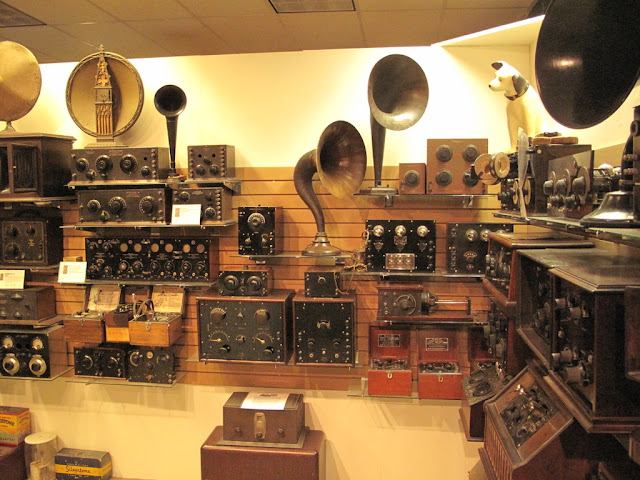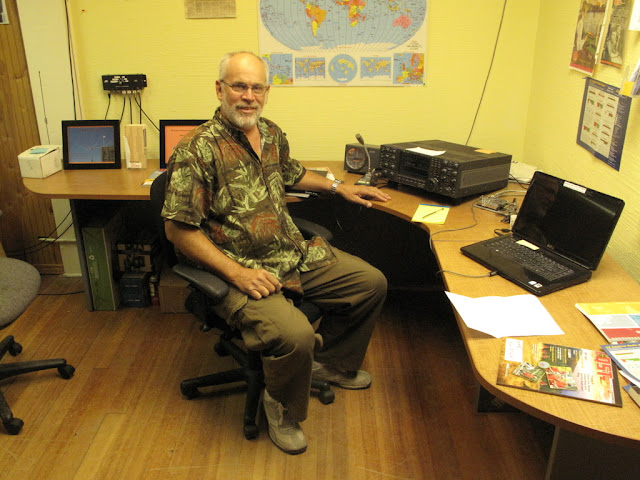Our day at the radio museum by Fred Lloyd
 QRZ visits the American Museum of Radio and Electricity
QRZ visits the American Museum of Radio and Electricity
Earlier this week we were treated to a tour of the American Museum of Radio and Electricity, a must-see landmark in the city of Bellingham, Washington. The AMRE is located in the central downtown district of the city and despite it's rather plain looking exterior, inside is one of the most interesting and engaging museums of its kind anywhere.
We were met by the museum's founder, John Jenkins, who graciously took time out of his busy day to give us a detailed private tour of the entire collection, including a fascinating behind-the-scenes look of the facility. John realized the dream of his life when, after retiring from his career in high-tech in 2001, began to build a museum consisting of items from a couple of private collections including his own that he started at age 13. John purchased a couple of run-down storefront buildings in his hometown of Bellingham and began a quest that has helped to revitalize a part of the downtown while become a key attraction for the city.

The museum includes more than 11 distinct period exhibits that commence with the very discovery of electricity itself, recreating the initial experiments of Ben Franklin, Ohm, Volta, Hertz, Tesla, and others. Here, you'll find Leyden Jars, static electricity experiments, some of the first batteries ever made, the first electromagnet, the earliest electric motors, and other devices that were truly genius for their time. Sometimes, you just have to stop and wonder how these great pioneers, some more than 400 years ago, had the insight and inspiration to make the discoveries they did.
As I looked at some of the experiments, such as Hertz's wave measurement device, I was humbled by the discoveries that were made using little more than a spark gap and a few pieces of wire and glass insulators. Here before me was a device that could be built from Home Depot plumbing parts that was responsible for the discovery of waves, wavelengths, and SWR, back before the concept of radio as we know it was even thought possible. Looking at his work, which took place in the middle of the 1800's, it is hard to imagine how far electromagnetic technology has since advanced. In less than 100 years after his death, we have satellites, microprocessors, cell phones, the Internet, and a whole world of technology that can be directly traced back to this early work.

The AMRE's exhibits take the visitor step by step into each successive generation of technology and soon we find ourselves in the crystal radio era, followed by the first light bulbs and vacuum tubes. Samuel Morse is also featured here and the real story behind the Morse Code is somewhat different that what one might expect. For example, did you know that Morse's first machine didn't use a telegraph key? Or that its operators, tired of having to work with a tempermental paper inscribing machine found it easier just to 'copy' the machines clicks and decode the messages in their heads and write them down? This story and many others are presented in wonderful detail for visitors to explore and the examples shown are presented either with vintage hardware or painstakingly accurate modern reproductions.
The overall collection is quite large with a catalog of many thousands of items to look at. Some pieces are truly one-of-a-kind and can't be seen anywhere else on the planet. Some of the radio gear is rivaled only by the Smithsonian and is truly priceless. The vacuum tube collection, for example, contains some of the rarest examples anywhere, and in some cases, the first prototypes that were ever produced.

The age of radio is presented with a collection of home receivers that is more comprehensive than any I've ever seen. Right along side are amateur radio sets, which as we all know share a common history with the earliest days of wireless communications. The collection includes numerous spark gap transmitters, early single tube designs, and a collection of more contemporary amateur radio gear from the 40's through the present. Their crown jewel is an Icom IC-7800 which is hooked up and available for visiting amateurs to operate on request. They also have a complete Collins S-Line station, and a Hallicrafters station, all setup and ready to go. The only thing missing are operators and I, for one, regret not having the time to sit down and spend some quality on-air time while I was there.

The above bears repeating: If you are a licensed amateur and would enjoy operating a brand new ICOM IC-7800 station then you definitely should go down to the AMRE and take the microphone (or key). The facility is staffed with a great many knowledgeable volunteers who are eager to spend time with you and your family.
Another thing that bears pointing out is that most of the items in the collection aren't behind glass or set back behind rope lines. A large number of the exhibits are hands-on and many of the rare collectables can be gently touched without setting off any alarms. You will feel completely at home here, as a member of the fraternity of radio and electronics world, as will your whole family. The admission is just $5 for adults, which is in incredible value considering its a place where you can literally spend hours wandering through the expansive collection.
In addition to the photos posted here, we've prepared a collection of more pictures here...
On your next visit to the pacific northwest, be sure and make Bellingham one of your destinations. It's a must-do, bucket list destination for any radio enthusiast.
The American Museum of Radio and Electricty is located at:
1312 Bay Street
Bellingham, WA 98225
Phone: 360.738.3886
Last edited by AA7BQ; Today at 10:03 PM.
 QRZ visits the American Museum of Radio and Electricity
QRZ visits the American Museum of Radio and Electricity
No comments:
Post a Comment